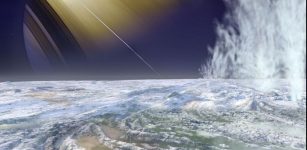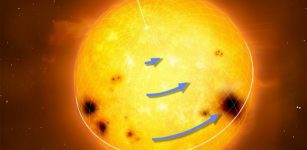Explosions Of First Stars Ejected Powerful Jets
Eddie Gonzales Jr. – MessageToEagle.com – Astronomers have found that the first stars may have blown apart in a more powerful, asymmetric fashion, spewing forth jets that were violent enough to eject heavy elements into neighboring galaxies.
These elements ultimately served as seeds for the second generation of stars, some of which can still be observed today.
In a paper published today in the Astrophysical Journal, the researchers from MIT and their Japanese colleagues report a strong abundance of zinc in HE 1327-2326, an ancient, surviving star (discovered by Frebel in 2005) that is among the universe’s second generation of stars.
They believe the star could only have acquired such a large amount of zinc after an asymmetric explosion of one of the very first stars had enriched its birth gas cloud.
“When a star explodes, some proportion of that star gets sucked into a black hole like a vacuum cleaner,” Anna Frebel, an associate professor of physics at MIT and a member of MIT’s Kavli Institute for Astrophysics and Space Research, said in a press release.
“Only when you have some kind of mechanism, like a jet that can yank out material, can you observe that material later in a next-generation star. And we believe that’s exactly what could have happened here.”
“The first stars were so massive that they had to explode almost immediately,” Frebel says.
“The smaller stars that formed as the second generation are still available today, and they preserve the early material left behind by these first stars. Our star has just a sprinkle of elements heavier than hydrogen and helium, so we know it must have formed as part of the second generation of stars.”
The researchers ran over 10,000 simulations of supernovae, each with different explosion energies, configurations, and other parameters and among them, there was only one that could explain the star’s makeup, including its high abundance of zinc, was one of an aspherical, jet-ejecting supernova of a first star.
Such a supernova would have been extremely explosive, with a power equivalent to about a nonillion times (that’s 10 with 30 zeroes after it) that of a hydrogen bomb.
The results of the study may shift scientists’ understanding of reionization, a pivotal period during which the gas in the universe morphed from being completely neutral, to ionized — a state that made it possible for galaxies to take shape.
“People thought from early observations that the first stars were not so bright or energetic, and so when they exploded, they wouldn’t participate much in reionizing the universe,” Frebel says.
These first supernovae could have also been powerful enough to shoot heavy elements into neighboring “virgin galaxies” that had yet to form any stars of their own.
“Once you have some heavy elements in a hydrogen and helium gas, you have a much easier time forming stars, especially little ones,” Frebel says.
Written by Eddie Gonzales Jr. – MessageToEagle.com Staff Writer











